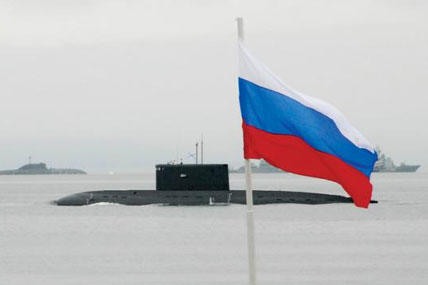Several U.S. lawmakers are warning U.S. military leaders about the pace and scope of Russia's Arctic militarization, including the addition new brigades, ships and airfields to the fast-changing region.
Russian initiatives are making it increasingly difficult for the U.S. to successfully compete in the area as new sea lanes emerge, they say.
"When you look at what the Russians are doing in the Arctic, it is actually quite impressive --impressive, but disturbing," Sen. Dan Sullivan, R-Ala., told military leaders at a recent Senate Armed Services Committee Navy budget hearing.
"The Russians are looking at adding four new combat brigades in the Arctic as our U.S. Army is thinking at pulling them out of there," he said. "I think that would give Vladimir Putin a lot of joy. They are building 13 new airfields and conducting long-range air patrols off the coast of Alaska."
Sullivan said the U.S. military is ill-advised to consider removing one or two Army Brigade Combat teams from Joint Base Elmendorf-Richardson and Fort Wainwright in Alaska.
"That we would even contemplate taking one soldier away from Alaska is lunacy given Putin's recent actions in the Arctic," he said. "Alaska's Army BCTs are the best cold-weather and mountain-hardened BCTs in the country. The training makes them uniquely valuable to the U.S. Army and their presence in Alaska hopefully ensures that other nations never make us use them."
Experts say the pace of melting ice and rising water temperatures is expected to open more waterways in the region and possibly new sea-routes for commercial shipping, transport, strategic military presence and adventure tourism. The developments carry geopolitical and national-security risks, as well.
Chief of Naval Operations Adm. Jonathan Greenert said the U.S. needs to intensify its preparations for Arctic activity.
"We need to look at it deliberately and understand it," he said. "We need to get industry up there and study the place and find out when it is going to melt. What are the sea lines that will open? Are there territorial disputes? Are there threats? Russia is increasing their military presence which sort of makes sense. Also, how do we survive up there with our ships our aircraft and our people?"
The Navy is researching technologies that will better enable sailors, ships, sensors and weapons to operate in such a harsh environment.
"We have to look at the hardening of our hulls," he said. "It is not just surface ships. It is the aircraft and the undersea domain. I've directed the increase in our activity up there."
The Office of Naval Research has deployed drones underneath the ice to assess the temperature and salt content of the water so as to better predict the pace of melting ice and the opening up of sea routes.
Greenert also said the Navy is increasing joint exercises with Canada and Scandinavian countries in preparation for increased Arctic activity.
Despite these measures, some lawmakers are still not convinced that the U.S. is doing enough to counterbalance Russian military initiatives in the region. Sen. Angus King, I-Maine, expressed concern that the U.S. only operates a handful of ice breaker ships compared to Russia's large fleet of ice breakers.
"We have one heavy duty and one medium-duty Coast Guard ice breakers," he said. "The Russians have 17 ice breakers in the Arctic. If we are talking about innocent passage and trade, ice breakers are the highway builders and that is an example of how we are really not adequately developing our strategic interests in that region."
Sullivan also echoed Sen. King's concerns about the small U.S. fleet of ice breakers, adding that the Russians have six new icebreakers in development with five more planned.
The U.S. has more than 1,000 miles of Arctic coastline along its Alaskan border. However, Russia's Northern Sea Route, which parallels the Arctic and Russian border, is by far the largest existing shipping route in the region.
Recognizing that the quickening pace of melting ice and warming water temperatures may open up sea lanes sooner than expected, the Navy last year released an Updated Arctic Road Map, which details the service's preparations for increasing its presence in the region.
The Navy's initial version of the document released in 2009 includes mission analysis and "fleet readiness" details for the environment, including search and rescue, maritime security, C4ISR, cooperation with the U.S. Coast Guard, strategic sealift and strategic deterrence, among other things.
"The Arctic is warming twice as fast as the rest of the globe," the document states. "While significant uncertainty exists in projections for Arctic ice extent, the current scientific consensus indicates the Arctic may experience nearly ice free summers sometime in the 2030s."
An assessment by the Navy's Task Force Climate Change determined the rate of melting has increased since the time of this report. As a result, Navy planners anticipate needing to operate there to a much greater extent by the middle of the 2020s instead of the 2030s.
Although the thinning of the Arctic ice was reported by Navy submarines in the 1990s, there have been considerable changes to the environment since that time, said Robert Freeman, spokesman for the oceanographer of the Navy.
While stressing that budget constraints might limit what preparations are possible, Navy Secretary Ray Mabus also said the service was increasing its exercises and preparations for greater activity in the region.
"As the ice melts in the Arctic our responsibilities go up. It is not just platforms and capabilities -- it is what we are facing," he said. "We not only have less ice but it is freezing in different ways. The ice is forming in different ways that are beginning to be a hazard to navigation. We're upping our exercises and research into the area."
-- Kris Osborn can be reached at kris.osborn@military.com




























